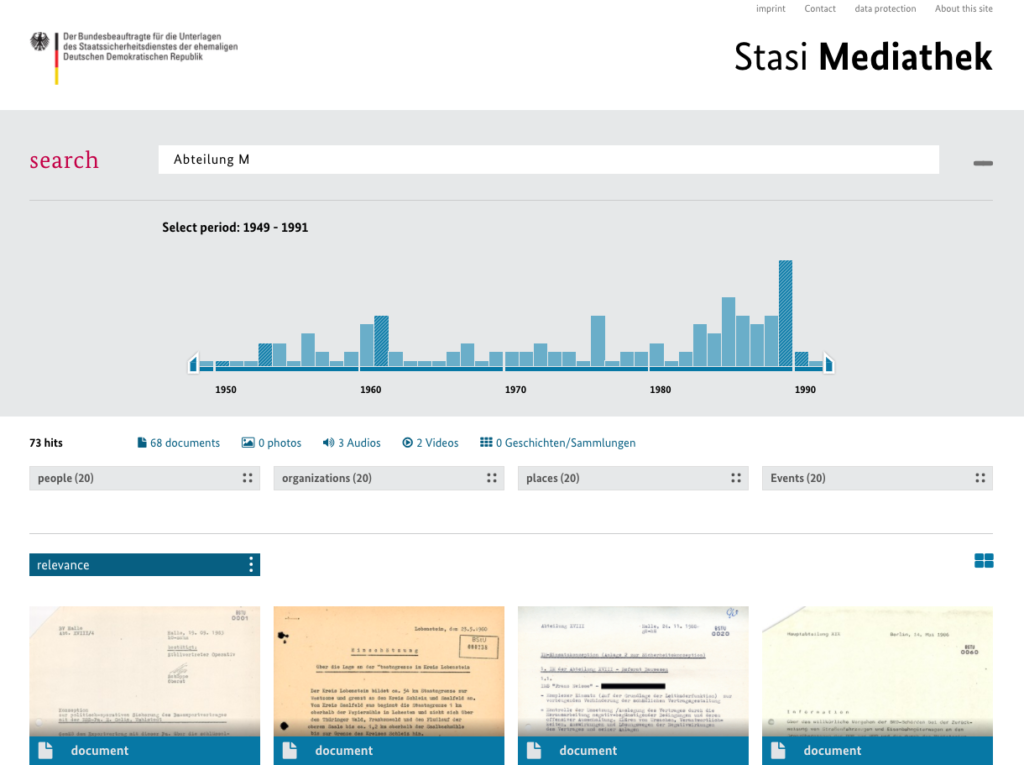The early days of the Stasi were marked by the development of new systems for monitoring the population. In the 1950s, having already incorporated a post-WWII file system used for denazification, the MfS implemented three new index card types to track citizens, all of which were stored in a central card index. These cards were distinguished by color and used to track persons considered hostile to the state (form A1 which was yellow), official staff (form B1, later replaced by the blue and grey F19), and persons who were arrested (the red, form C1).
While official staff had titles and were on the payroll, the Stasi used hundreds of “unofficial staff.” These “Inoffizielle Mitarbeiter” (or IMs) were either foreign citizens who turned over valuable information like trade secrets, or domestic informants who spied on their colleagues, neighbors, and relatives (and sometimes even spouses). While money was a primary motivation, they were compelled for a number of other reasons, including blackmail, ideological commitments to the GDR, or gifts other than money, like lavish vacations, prostitutes, and official state awards. In fact, the Stasi implemented an impressive number of medals and rewards in order to convince both IMs and official staff to maintain loyalty and faithfully contribute their labor to the state. (Macrakis, loc 386) These awards are not unlike the loyalty cards, badges, and other gamification tactics that today’s corporations employ across their databases of customers in order to increase brand allegiance and sales.
Similar to modern software development, the Stasi index card systems, like many of their methods over the years, were constantly being reworked and improved with each new iteration. For example, while the previous system used separate cards to track “enemies” and “friends,” as the Stasi learned to coerce those formerly consider hostile into becoming secret informants it became necessary to track persons who evolved into “frenemies of the state.”
This situation presented a particular problem, as the Stasi needed to record and track personal data on these people, but their real identities needed to be protected should they agree to turn over valuable information. For these persons the Stasi implemented a separate “transaction card” (F22) that augmented the standard cards. The change updated the yellow card (F16, formerly A1), which contained the real name, address, birth date and place, occupational status, workplace or school, and the red card (F18, formerly C1), used for those arrested, which contained this information, as well as a mugshot, a visual description, and data related to their crime, and added a registration number if they were a Stasi informer or agent. (The Key to Power, 3–4)

The central operation card “F22” Credit: BStU
The new “transaction card” (F22) recorded Stasi informants only by this registration number, as well as a secret code name and name of the case officer who managed the agent. Finding the real name of a Stasi operative meant matching not only the registration numbers on these cards, but additional comparisons, because many agents purposely shared registration numbers to add extra layers of secrecy. (Macrakis, 78) This method is similar in theory to modern relational database lookup tables, where a user’s personally identifiable information (PII) is separated and protected from data dumps containing so-called “anonymized data” , or public key encryption, where data is transmitted securely by performing mathematical operations on it using a combination of a unique private and public key.
- The key to power: Card indexes and other finding aids practices of State Security. Archivar 64. Jahrgang Heft 04 November 2011.
- Macrakis, Kristie. Seduced by Secrets: Inside the Stasi’s Spy-Tech World (Kindle Location 1615). Cambridge University Press.
- Jason Koebler This Visualization of NYC’s Taxis Shows the Promise and Pitfalls of Big Data Motherboard (2014)
- Alex Hern New York taxi details can be extracted from anonymised data, researchers say The Guardian (2014)









